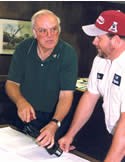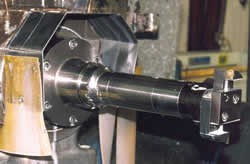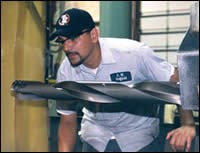Heavy-Duty Hole Making
A modular drilling and boring system has changed this oilfield product manufacturer's holemaking operations.
Share


Improvements in holemaking operations can have a major impact on overall productivity. Southwest Oilfield Products, Inc. (Houston, Texas) proved the point when it switched from more traditional drilling and boring tools to a modular, quick-change tooling system. In most cases, the conversion resulted in a tenfold or better improvement in drilling and boring rates for the company’s hole-intensive parts.
Southwest manufactures an extensive line of products for the oil and gas drilling industry. In particular, the company makes pumps, called fluid ends, which are used to extract sand, clay, and so forth, from wells as they are being drilled. The pumps are also called mud pumps since they force a mud slurry into the shaft at pressures up to 7,500 psi to displace the unwanted materials. The company also makes an extensive line of replacement parts for such pumps, including pistons, liners, valves and seats.
The fluid end is an L-shaped assembly consisting primarily of a cube-shaped suction module bolted to a larger (twice as tall) discharge module. Lesser components include a valve cover for each module and internal components such as pistons and piston rods. Both modules are made from solid forged blocks and are hole intensive, having large and in some cases intersecting bores and numerous, large-diameter fastener through-holes.
In the past, the suction and discharge modules were machined on large, conventional milling and boring machines using spade drills and single-point boring tools. The spade drill was used to create an initial hole, about 4 inches in diameter, which was then enlarged to about 9 inches in diameter by successive passes with a single-point boring tool. The process left a lot to be desired: The metal-removal rates were slow to begin with, but machining times were dragged out by frequent tool changes and checks of tool settings on the machines.
Southwest knew that it needed a more efficient holemaking process; therefore it was receptive when Roger Carrotte, a Cypress, Texas-based sales engineer for Komet of America, Inc. (Schaumburg, Illinois) called to ask if Southwest would be interested in exploring ways that it might improve its drilling and boring rates using Komet’s ABS modular tooling system. Mr. Carrotte explained, in much greater detail than this space permits, that the ABS system consists of a female receptacle incorporated in the machine tool spindle and an insert-type cutting tool that fits into the receptacle and is secured by tightening a clamping screw. Major advantages of the system include the following: the ability to quickly replace the tool in the receptacle with another ABS tool (only one screw to loosen/tighten); precise location of the tool in the receptacle, obviating the need to reset the tool on the machine; and accurate cuts, even for tools with high length-to-diameter ratios, thanks to the tool’s rigid mechanical clamping system.
Mr. Carrotte convinced Southwest of the benefits of the ABS system and agreed to work closely with the company to install the system on a turret lathe that would be completely rebuilt as a special drilling and boring machine. The turret was removed from the machine and replaced with an indexing table large enough to hold the suction and discharge modules of the mud pump. The lathe’s motor was replaced, and an ABS adapter was installed in the spindle.
Southwest tooled the rebuilt machine with a Kub V46 insert-type ABS drilling system, consisting of three spiral-fluted drill bodies designed for 4.2×, 6× and 8× diameter drilling depths, and several drill heads that attach to the drill bodies. Each drill head has a different diameter.
Southwest also purchased a set of ABS, twin-cutter, rough-boring tools for the machine. Similar in concept to the ABS drilling system, the boring system employs quick-change boring heads that install quickly (20 to 30 seconds) and easily on a boring tool extension mounted in an adapter in the machine tool’s spindle. The adapter enables the machine operator to quickly switch from drilling to boring operations.
Drilling and boring of the fluid end modules improved dramatically with the ABS system. Previously, an initial 4-inch bore was spade-drilled in each module at a rate of about 1/2 inch per minute (ipm). Using the ABS system, the drilling rate jumped to 4 1/2 ipm. Previously, the 4-inch drilled hole was enlarged to a 9- or 10-inch-diameter bore through successive passes with a single-point boring tool on a different machine. The single-point boring tools were limited to a 1/4-inch depth of cut, and the boring proceeded at less than 1 ipm. The ABS twin-cutter boring system permits 1/2- to 5/8-inch depths of cut at speeds to 9 ipm.
The dramatically improved machining rates achieved in the rough drilling and boring operation proved the benefits that could be gained with ABS tooling installed on machines configured to take full advantage of its potential. Accordingly, Southwest began looking for opportunities to extend the use of the ABS tooling to downstream machining operations.
After the fluid end modules are roughed out on the special drilling and boring machine, they go to heat treat. When they come back, each module goes through a straddle milling operation that finish mills all six faces, and then to a rebuilt DeVlieg Jigmil, equipped with ABS tooling, that handles the internal bores and pocket work.
Modifications made to the Jigmil include the addition of a facing head in which the boring bar is mounted. Here, too, the emphasis is on quick change: The operator has a cradle positioned alongside the machine table where the various boring bar heads needed for the module being machined can be stored. The operator simply loosens one screw (with the Allen head wrench seen on the boring bar in this photo), removes one boring bar head and inserts another. The switch can take as little as 15 seconds for even the heaviest tool.
Operations on the Jigmil include contouring the module’s cavity. Both front boring and back boring operations are involved. The operator needs to change quickly from one operation to the other. The Komet connector makes the process not only fast but also accurate. The operator does not need to reset the tool after changing heads.
From the Jigmil, the modules go to a relatively new Toyoda horizontal machining center for finish machining operations that include drilling of long bolt holes, tapping and finish boring. The HMC is equipped with a 120-tool toolchanger that enables the machine to go from machining one part to another without having to pause to make tool substitutions in the magazine.
A good sales representative finds other ways to be helpful to customers, and in addition to advising Southwest on tooling-related matters, Mr. Carrotte has shared his expertise in non-cutting tool areas as well. For example, he designed a universal fixture system for Southwest’s HMC that will accommodate any of the various suction and discharge modules that go across the machine. In the photo to the right, two smaller suction modules are about to replace the single larger discharge module which has just been machined.
His biggest contribution, however, remains introducing Southwest to ABS tooling. Use of the ABS system has spread beyond the fluid end department to the company’s other part machining areas. Jimmy Skinner, Southwest’s CNC programmer/supervisor, is an unabashed fan, both of ABS and Komet’s Roger Carrotte: “Once we converted all of the machines in the fluid end department to ABS, our monthly production increased nearly tenfold.” (He declined to reveal the actual production numbers for competitive reasons.)
“The improvement was due primarily to the tooling,” Mr. Skinner affirms. “Specifically, the time saved in changing out tooling and not having to requalify the tool after each use. It made a big difference.
“The tooling also improved our ability to respond to our customers’ needs,” he continues. “Before, our delivery time was 2-3 months; now, our delivery time is about 2 weeks. We’ve increased production so dramatically that we can maintain a modest inventory—something we could never do before because we would sell our products as fast as we made them.”
Related Content
Orthopedic Event Discusses Manufacturing Strategies
At the seminar, representatives from multiple companies discussed strategies for making orthopedic devices accurately and efficiently.
Read MoreMeasuring Torque, Thrust Force for Smart Drilling Operations
To monitor drilling operations for smart manufacturing solutions, torque and thrust force can be measured.
Read MoreFinding the Right Tools for a Turning Shop
Xcelicut is a startup shop that has grown thanks to the right machines, cutting tools, grants and other resources.
Read More
































